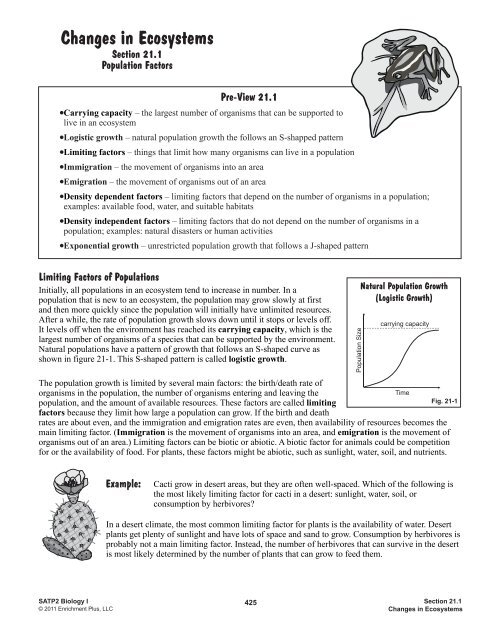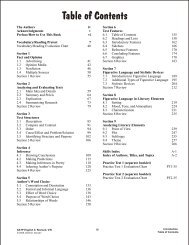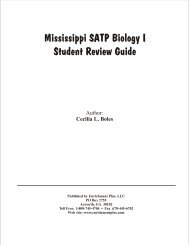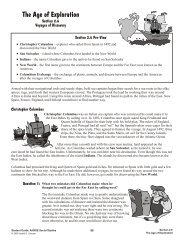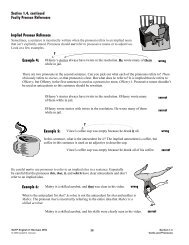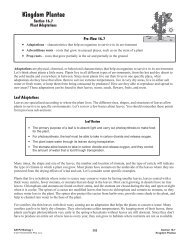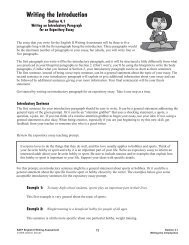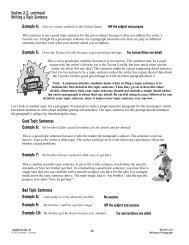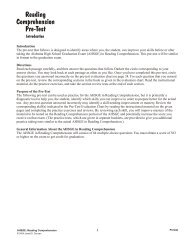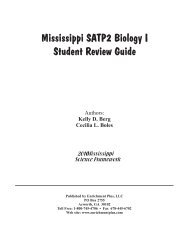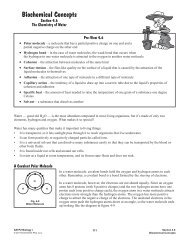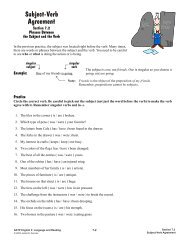Mississippi SATP2 Biology I Student Review Guide - Enrichment Plus
Mississippi SATP2 Biology I Student Review Guide - Enrichment Plus
Mississippi SATP2 Biology I Student Review Guide - Enrichment Plus
Create successful ePaper yourself
Turn your PDF publications into a flip-book with our unique Google optimized e-Paper software.
Changes in Ecosystems<br />
Section 21.1<br />
Population Factors<br />
Pre-View 21.1<br />
! Carrying capacity – the largest number of organisms that can be supported to<br />
live in an ecosystem<br />
!Logistic growth – natural population growth the follows an S-shapped pattern<br />
! Limiting factors – things that limit how many organisms can live in a population<br />
!Immigration – the movement of organisms into an area<br />
!Emigration – the movement of organisms out of an area<br />
! Density dependent factors – limiting factors that depend on the number of organisms in a population;<br />
examples: available food, water, and suitable habitats<br />
! Density independent factors – limiting factors that do not depend on the number of organisms in a<br />
population; examples: natural disasters or human activities<br />
!Exponential growth – unrestricted population growth that follows a J-shaped pattern<br />
Limiting Factors of Populations<br />
Initially, all populations in an ecosystem tend to increase in number. In a<br />
population that is new to an ecosystem, the population may grow slowly at first<br />
and then more quickly since the population will initially have unlimited resources.<br />
After a while, the rate of population growth slows down until it stops or levels off.<br />
It levels off when the environment has reached its carrying capacity, which is the<br />
largest number of organisms of a species that can be supported by the environment.<br />
Natural populations have a pattern of growth that follows an S-shaped curve as<br />
shown in figure 21-1. This S-shaped pattern is called logistic growth.<br />
Population Size<br />
Natural Population Growth<br />
(Logistic Growth)<br />
carrying capacity<br />
The population growth is limited by several main factors: the birth/death rate of<br />
organisms in the population, the number of organisms entering and leaving the<br />
Time<br />
population, and the amount of available resources. These factors are called limiting<br />
factors because they limit how large a population can grow. If the birth and death<br />
rates are about even, and the immigration and emigration rates are even, then availability of resources becomes the<br />
main limiting factor. (Immigration is the movement of organisms into an area, and emigration is the movement of<br />
organisms out of an area.) Limiting factors can be biotic or abiotic. A biotic factor for animals could be competition<br />
for or the availability of food. For plants, these factors might be abiotic, such as sunlight, water, soil, and nutrients.<br />
Fig. 21-1<br />
Example:<br />
Cacti grow in desert areas, but they are often well-spaced. Which of the following is<br />
the most likely limiting factor for cacti in a desert: sunlight, water, soil, or<br />
consumption by herbivores?<br />
In a desert climate, the most common limiting factor for plants is the availability of water. Desert<br />
plants get plenty of sunlight and have lots of space and sand to grow. Consumption by herbivores is<br />
probably not a main limiting factor. Instead, the number of herbivores that can survive in the desert<br />
is most likely determined by the number of plants that can grow to feed them.<br />
<strong>SATP2</strong> <strong>Biology</strong> I<br />
© 2011 <strong>Enrichment</strong> <strong>Plus</strong>, LLC<br />
425<br />
Section 21.1<br />
Changes in Ecosystems


